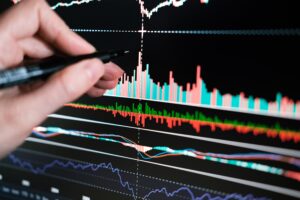In 2025, range-bound trading continues to offer steady profit potential for short-term forex traders. This strategy thrives in calm markets where prices move between well-defined support and resistance levels. Traders who understand how to capitalise on these conditions can earn consistently even when the market lacks a clear trend. Unlike trend-based strategies, range trading focuses on sideways price movement within price consolidation zones.
Rather than relying on fast-moving trends or volatile breakouts, range-bound trading emphasises structure and repetition. The more predictable the market’s behaviour within a range, the better the opportunities to capitalise on repeated movements. Many traders in 2025 use this approach as their primary method due to its low-risk nature and ease of implementation.
Range-bound trading also suits various personality types. Traders who prefer a patient, rules-based approach will find this strategy particularly helpful. It allows for systematic entries and exits without the emotional rush that often comes with scalping or aggressive trend-following.
What Is Range-Bound Trading?
Range-bound trading is a method that focuses on identifying a sideways market. In this type of setup, the price moves repeatedly between two boundaries—support at the bottom and resistance at the top. Traders use this range to open buy and sell positions based on reversal signals near these levels.
This strategy is especially helpful in a sideways market, where price lacks momentum and fails to break out. Instead of chasing trends, the range trader anticipates price movement within confined zones. This predictability offers a structured approach for earning short-term gains with minimal exposure to market noise.
In modern forex markets, sideways movement accounts for a large percentage of daily price action. Recognising this gives traders an edge. They can prepare to take advantage of predictable reversals rather than guessing trend direction. For traders focused on consistent performance, range-bound setups can become a foundation for building sustainable income.
Range-bound setups are especially useful in major currency pairs like EUR/USD, GBP/USD, and USD/JPY. These pairs tend to respect technical levels and often consolidate after strong moves. Traders who master range recognition can find multiple profitable opportunities each week without needing large trends.
Why Range-Bound Trading Works in 2025
Markets in 2025 are more reactive to data but often revert to price consolidation zones between big moves. During such periods, range trading becomes a valuable tactic. This method works because most markets spend more time ranging than trending. Understanding this behaviour helps traders prepare for low-volatility setups and identify profitable entry points.
With enhanced charting platforms and sentiment tools now available, recognising a sideways market is simpler than ever. Indicators like RSI and Bollinger Bands help confirm when price respects its range boundaries. This reduces guesswork and allows more precise decision-making.
Algorithmic activity and institutional trading often push markets into narrow zones of indecision before major announcements. Retail traders can benefit by recognising these ranges early. When they trade with discipline, the risk-to-reward ratio can become favourable even with small market moves. As a result, range-bound strategies have gained popularity among professionals and individual traders alike.
Seasonal market behaviour also supports this strategy. For instance, summer months often see lower volatility, increasing the likelihood of range conditions. Range-bound systems thrive during these periods, especially when economic calendars are light.
How to Identify a Valid Trading Range
Recognising the correct range is crucial. A valid trading range shows at least two or more touches at the same price level—both on the support and resistance side. The price should remain confined within this space over a sustained period, indicating market balance.
To identify a proper range:
- Use higher timeframes like H4 or D1 to spot obvious price consolidation zones.
- Confirm range levels with lower timeframes for better entry points.
- Watch for volume and volatility shifts to determine if the range is stable.
If candles are tight and momentum is weak, it’s likely a sideways market. Enter positions at range boundaries using confirmation tools like pin bars, engulfing patterns, or divergence signals.
The longer a range holds, the stronger its boundaries become. Traders who observe multiple failed breakout attempts gain more confidence in trading the bounce. However, it’s still essential to stay alert. Ranges can break without warning, especially during macroeconomic events.
News-based ranges also deserve attention. Ahead of major reports like Non-Farm Payrolls or central bank decisions, the market often moves sideways in tight ranges. These ranges may break violently once the news is out. Traders must either trade within the pre-event range or wait for post-event clarity before entering positions.
The Core Forex Range Trading Strategy
A reliable Forex range trading strategy starts with mapping out the range boundaries. Once the range is confirmed, wait for the price to touch support or resistance and observe price behaviour.
Traders typically:
- Go long (buy) near support when bullish signs appear.
- Go short (sell) near resistance when bearish signals are evident.
- Exit trades near the opposite end of the range.
Avoid holding trades once price breaks out of the range. Always place stop-loss orders just outside the boundaries to reduce risk.
Some traders enhance this strategy with volume analysis. A bounce from support with rising volume suggests stronger buying interest. Conversely, declining volume near resistance may signal weakening momentum and a potential reversal. Combining such clues with candlestick analysis improves accuracy.
Advanced traders add additional confirmation by monitoring the order flow or using footprint charts. These tools show buyer and seller activity at each price level, helping traders detect hidden accumulation or distribution within a range. Though not essential for beginners, these tools provide an extra edge when used correctly.
Technical Indicators That Enhance Range Trading
Price action is key, but indicators improve timing and confirmation.
- RSI helps identify overbought and oversold conditions near range edges.
- Stochastic Oscillator adds momentum confirmation in choppy setups.
- Bollinger Bands visualise range limits, especially when bands narrow.
Use these tools in combination with clear support and resistance levels. Too many indicators can complicate decisions, so simplicity helps achieve consistency.
Another useful tool is the Average True Range (ATR). It measures volatility and helps determine the range’s strength. When ATR is low and price is stable, range-bound setups are more likely to hold. Traders use ATR to set realistic stop-loss levels and predict potential price movement within the range.
Additionally, moving averages like the 20 EMA can be useful in gauging the centre of the range. Price oscillating around a flat 20 EMA often indicates a balanced market. Traders may use this midpoint for partial exits or trade management within larger ranges.
Common Mistakes Traders Make in Range-Bound Markets
Range trading is effective but requires patience and discipline. Common errors include entering trades too early, before the range is fully formed. Without confirmed boundaries, losses happen quickly.
Other mistakes include:
- Overtrading inside narrow ranges with limited profit potential.
- Relying only on indicators without confirming price behaviour.
- Ignoring volume changes that may hint at an upcoming breakout.
Holding trades during major news events is also risky. Central bank moves or geopolitical shocks can break any sideways structure without warning.
Emotional decision-making is another danger. Impatient traders may enter too early or exit too late, hoping to squeeze more profits. Sticking to a written plan, with predefined entries and exits, is the best way to avoid these pitfalls.
Another mistake is trading every range that appears on the chart. Not all ranges are worth trading. Avoid ranges that are too narrow, too choppy, or too close to major news events. Filter your setups by quality to improve your win rate and reduce frustration.
Risk Management in Range Trading
Every trading range eventually ends. Proper risk control ensures that one failed trade doesn’t undo consistent gains.
To manage risk:
- Use stop-loss orders just beyond range levels.
- Set clear take-profit points near the opposite side of the range.
- Limit risk per trade to 1% of account capital.
Assess each range setup individually and review conditions if multiple trades fail within the same zone.
Traders can also use position sizing techniques to manage risk. Smaller trade sizes allow for wider stops, giving more room for market fluctuations. Trailing stops can also protect profits as price nears a range boundary. By locking in gains while reducing exposure, traders stay protected against surprise moves.
Some traders use fixed reward-to-risk ratios, such as 2:1 or 3:1. This ensures that even with a lower win rate, profitability remains intact. Combining this with strong setups allows traders to grow their capital steadily over time.
When to Avoid Range-Bound Trading
Some conditions are unsuitable for range trading. During high-impact news releases or unexpected global events, markets break out of ranges quickly.
Also avoid range setups when:
- Price begins forming higher lows or lower highs.
- The market shows signs of building momentum.
- Consolidation volume dries up, suggesting a breakout.
In such cases, switch to trend or breakout strategies. Recognising when a strategy no longer fits is crucial for long-term trading success.
Markets driven by emotion or fear can also distort ranges. Unexpected news can cause prices to spike briefly outside the range before returning. These fakeouts can trap undisciplined traders. To avoid this, it’s wise to trade only confirmed setups with multiple forms of validation.
Another red flag is divergence between different currency pairs. If correlated pairs begin trending while your target pair remains in a range, it may signal an impending breakout. In such cases, avoid opening new positions until the situation becomes clearer.
Advantages of Range-Bound Trading
Range-bound trading offers many advantages for short-term traders. It works especially well during low-volatility conditions. By focusing on known price levels, it minimises guesswork and provides structure.
Key benefits include:
- Predictable price behaviour within support and resistance levels.
- Lower drawdowns compared to trend chasing.
- Flexibility to suit both intraday and swing traders.
This strategy fits traders who prefer visual setups and steady results without depending on aggressive market movement.
Another advantage is mental clarity. Traders know where to enter and exit before placing the trade. This removes emotional stress and promotes discipline. Ranges often repeat over time, so traders can build confidence through repetition.
In addition, this strategy suits traders in multiple time zones. Whether you trade Asian, London, or New York sessions, range setups appear across all periods. That flexibility makes this approach practical for full-time and part-time traders alike.
Final Thoughts:
Despite changes in market technology and volatility, range-bound trading continues to perform. It gives traders a simple, rule-based approach that works well in sideways conditions.
When used with discipline and sound risk management, this strategy offers a consistent way to earn in forex. Understanding when to apply it and when to stay out is the difference between profit and frustration.
In 2025, range-bound trading remains a go-to method for traders who value clarity, structure, and steady returns.
By blending technical tools with price action and psychology, traders create a repeatable system. As markets evolve, those who stick to proven strategies like range-bound trading can enjoy long-term profitability and peace of mind.
Consistency, patience, and adaptability are the core strengths behind this method. Traders who refine their setups and continue to learn will find range trading a valuable ally in their journey toward financial growth.
Read here to learn more about ” Currency Wars: Are We Facing Another Devaluation Cycle?“

I’m Chaitali Sethi — a seasoned financial writer and strategist specializing in Forex trading, market behavior, and trader psychology. With a deep understanding of global markets and economic trends, I simplify complex financial concepts into clear, actionable insights that empower traders at every level. Whether it’s dissecting winning strategies, breaking down market sentiment, or helping traders build the right mindset, my content bridges the gap between information and implementation.




